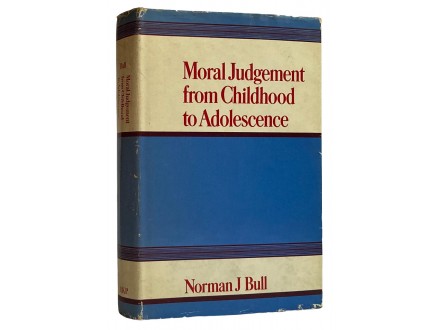Moral Judgement from Childhood to Adolescence
| Cena: |
| Želi ovaj predmet: | 3 |
| Stanje: | Polovan bez oštećenja |
| Garancija: | Ne |
| Isporuka: | Pošta CC paket (Pošta) Post Express |
| Plaćanje: | Tekući račun (pre slanja) |
| Grad: |
Novi Sad, Novi Sad |
Godina izdanja: Ostalo
ISBN: Ostalo
Jezik: Engleski
Autor: Strani
U dobrom stanju, pečat biblioteke
Moral Judgement from Childhood to Adolescence
Norman J. Bull
Publisher: Beverly Hills : Sage Publications
Publication Date: 1969
Binding: Hardcover
Book Condition: Good
Dust Jacket Condition: Dust Jacket Included
Published in 1969 this book analyzes the development of moral judgement in children and adolescents. Interviews were held with 360 children aged 7 to 17, with equal numbers of either sex. Original visual devices were planned to elicit judgements in moral areas known to be of universal significance, such as the value of life, cheating, stealing and lying.
ccompanying Dr. Bull`s main concern to trace the growth of moral judgement, is a statistical analysis to seek evidence of correlation with four key variables sex, intelligence, socioeconomic background and religious influence. In addition, analyses of concepts of reciprocity, of the development of conscience and of specificity in moral judgement were derived from the tests. The book inlcudes a critical survey of previous work in this field and places the research in its wider philosophical, psychological and sociological context.
Contents
Preface ix
1. The study of moral judgement 1
The contemporary scene
A changing society
The impact of new knowledge
Religion and morality
Assessing moral development
The origin of conscience
The relevance of psychology
Early studies
The work of Piaget
The morality constraint
The morality of co-operation
Critique of Piaget
Stages of development
The Character Education Enquiry
University of Chicago Studies of Values
The psychoanalytic approach
Moral values
Moral education
2. The pattern of development 26
Stage and development
Levels of judgement
Anomy: pre-morality
Heteronomy: external morality
Socionomy: external-internal morality
Autonomy: internal morality
Sequential stage development
Variable factors
Socio-economic background
The home
Religious influence
Sex differences
Intelligence
The place of variables
3. The research project 46
Purpose
Methodology Projection tests
S-Coring
Verbalism
Constructing visual tests
Selection of moral situations
Depicting the five moral themes
The individual interview
Pre-testing
Pilot testing
The final sample
Age
Intelligence (I.Q.)
Socio economic class
Religious class
Church attendance
Religious attitudes
The research project
4. The value of life 67
The test
Is saving life instinctive?
Sympathy and the maternal instinct
Responses
Conclusions
1. Levels of judgement
2. Developmental changes
3. Sex differences
4. Stability in judgement
5. The sacredness of life
5. Reciprocity and conscience 90
The nature of reciprocity
The range of reciprocity
Reciprocity and conscience
The nature of conscience
The genesis of conscience
The super-ego
The ego-ideal
Types of conscience
Conscience in action
Definitions of conscience
The development of conscience
Factors affecting conscience
6. Cheating 116
Test Situation
Responses
The pattern of development
Comparison with Piaget’s results: classroom
Comparison with Piaget’s results: games
7. Stealing 145
The test situation
Responses
The pattern of development
Stealing by finding and keeping
The pattern of development
8. Lying 175
The lying situation
Telling the truth
Definition of a lie
Why is lying wrong?
Responses
The pattern of development
Lying to children and adults
Lying to parents
9. Specificity and generality in lying 208
Piaget and telling tales
Specificity
Consistency
Lying for a friend
Reciprocity in lying for a friend
While Lies
The conditional legitimacy of lying
10. Written tests 229
The purpose of written tests
(A) The ideal person test
(B) Virtues and vices
(C) Choosing reasons test
(D) Right or wrong stones
(E) Concepts of justice
(F) Sentence-completion
11. Statistical analysis 276
Methodology
General discussion
1. The broad pattern
2. Conscience development
3. Intelligence
4. Socio-economic class
5. Religious class
6. Sex differences
7. The tests
8. Conclusion
Bibliography 289
Index 301
L_I_Č_N_O______P_R_E_U_Z_I_M_A_NJ_E_:
Za kupovine ukupne vrednosti preko 3.000 dinara moguće lično preuzimanje u Puškinovoj u Novom Sadu. Ako je za pojedinačnu knjigu navedena samo opcija Pošta, lično preuzimanje samo te knjige nije moguće. U Novom Sadu moguća je lična dostava i plaćanje preko službe Eko-kurir (cena je 250-350 din).
STANJE KNJIGE:
Knjiga koju dobijate je ona koja je na slici. Ukoliko nije naznačeno da je knjiga nova ili nekorišćena, ponekad se desi da na predlistu stoji potpis, posveta ili pečat i da to nije navedeno u opisu. Ako vam takve stvari smetaju, pitajte me pre kupovine da proverim.
KOMUNIKACIJA:
Komunikacija ide isključivo preko Kupindo poruka, ne telefonom. Budite normalni.
POPUSTI, CENKANJE I SL.:
Cena je ta koja piše, molim vas da mi ne šaljete pitanja o poslednjoj i zadnjoj ceni niti svoje kontraponude.
SLANJE:
Knjige šaljem kao tiskovinu ili CC paket nakon uplate na račun. Pakujem ih bezbedno i pažljivo, dobijate ih u stanju u kojem su poslate. Poštarina za jednu pošiljku obično iznosi od 190 do 260 din, u zavisnosti od težine. To je poštarina za tiskovinu, CC paket je skuplji, post ekspres je najskuplji. Za četiri i više pojedinačno kupljenih knjiga (u to ne spadaju kompleti) ja snosim troškove poštarine. Potrebno je da uplatite/preuzmete knjigu u propisanom roku od 7 dana.
SUSEDNE ZEMLJE I INOSTRANSTVO:
Poštarina je za jednu knjigu visoka i okvirno se kreće od 10-15 eur za prvu i oko 7 eura za svaku dodatnu knjigu. Postoji mogućnost znatno isplativijeg slanja za teže pakete. Uplate PayPalom (+10%), direktno na devizni račun, Western Union ili Moneygram. Najbolje je da pre kupovine pitate koliki su troškovi dostave, jer su često veći od cene same knjige.
INTERNATIONAL ORDERS:
I will send abroad. For your calculation, one hundred dinars roughly equals $1. Please register here:
https://www.limundo.com/Registracija/Kupindo
and then PM me on the link below for postage costs (they usually start at around 15 euro for the first book and 7 euro for each additional one)
https://www.kupindo.com/Clan/ndi/PostaviPitanje
MOJA PONUDA:
Nove knjige postavljam gotovo svaki dan. Možete ih pratiti na ovom linku http://www.limundo.com/Clan/ndi (pritisnite dugme `Prati`)
¤¤¤¤¤¤¤¤¤¤¤¤¤¤¤¤¤¤¤¤¤¤¤¤¤¤¤¤¤¤¤¤¤¤¤¤¤¤¤¤¤¤¤¤¤¤¤¤¤¤¤¤¤¤¤¤¤¤¤¤¤¤¤¤¤¤¤¤¤¤¤¤¤¤¤¤¤¤¤¤¤¤¤¤
Predmet: 71070065







